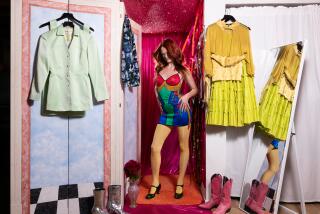Fashion Victim
I come not to bury Cargo--the menâs shopping magazine that folded to the told-you-so satisfaction of many in the publishing world last month--but to give it an old fashioned, rib-spreading autopsy. Iâve got the penultimate issue right here.
Immediate cause of death? Nick Lachey is on the cover, looking ever so much like a llama wearing lip gloss.
Cargo joins Vitals and Sync in Madison Avenueâs morgue of mag-alogs, a recent genre of anti-magazine scrubbed of anything that resembles an idea in favor of pages and pages of stuff about stuff--fitted jeans, cellphones with pop-art graphics, skin-care products, and, most dubitable of all, fashion advice. âI have two pinstripe suits, one gray and one black,â writes Danny M. in Weslaco, Texas. (Yeah, right!). âWhat non-solid ties and shirts can go with each?â
He lives in Texas? May I suggest Garanimals.
Launched by Conde Nast two years ago as the gentleman companion to Lucky--aimed at shopping-addicted mall molls--Cargo sought out that genetically modified form of life known as metrosexual, which upon reflection now seems like the hallucinatory creation of somebodyâs advertising department: males 25-45, fashion forward (and yet somehow fashion backward), with mad cash and all the time in the world to prowl boutiques and gallerias. A slightly less politically correct term: gear queers.
I remember seeing the first issue of Cargo in March 2004--a cinder-block-sized monster to rival Vogue--and wondering if men could possibly have become so comfortable with their own vanity that such a publication could be sustained. Clearly not.
I reject on its face the notion that American men are more concerned about their appearance than they used to be--but that might just be because Iâve spent a lot of time recently flying commercially. More concerned than when, exactly? The 1890s, when men worked in starched collars with their heads running with macassar oil? The 1970s, when serious businessmen whittled mutton-chop sideburns onto their cheeks to go with their turtlenecks and burgundy blazers?
Cargo, then, stumbled over a rather low and self-evident obstacle. Men donât want to be made aware of their vanity. Yet every page of Cargo is a supercilious mirror held up to its readers: Yes, you too can look like the lobotomized man-child in the Prada sunglasses ad, the prissy anorexic in white shoes and no socks in the Lacoste ad. Magazines such as GQ and Esquire offer their readers the face-saving sanctuary of articles about world affairs or profiles of literary figures. Reading Cargo is like getting caught at a strip clubâs happy hour. You canât say youâre there for the food.
In other words, no one wants to feel like a materialistic tool, even materialistic tools.
In an interview with the New York Times, Cargo editor Ariel Foxman seemed at a loss to explain the hostility the magazine generated (the Washington Post memorably accused it of âfoppery, frippery, metrosexuality, the commercialization of everything and the wimpification of Americaâ).
And his confusion is understandable, seeing as how much the same could be said of every lad-mag and menâs lifestyle publication on the rack. But it was the editorial de-contenting of Cargo--the near vacuum of independent judgment, of live-ammo criticism about what stereo systems were overpriced dreck and which clothes were the ill-fitting spawn of Macau sweatshops--that made the magazine such an affront. When it comes to fashion, men need help, not more clever vectors for advertorials.
As Cargo moved toward its denouement, it began running more stories about sex and celebrities, but these only seemed to muddle matters. The April issue has a service article about erectile-dysfunction products such as Viagra. If E.D. is your problem and you are in your 20s, perhaps you are spending too much energy accessorizing. Perhaps your Ferragamos are too tight.
Nothing exemplifies the magazineâs awkward desperation better than the cover blurb: âBetter than sex! 317 brand-new products!â Excuse me, gentlemen, but there are no products better than sex, much less 317 of them.
A great deal has been made of where Cargo falls on the gay/straight axis, and itâs been suggested that the magazine might have survived if it had only come out of the closet. Iâm not so sure.
You may anatomize as you like about gender and grooming, shopping and sexual orientation, but men simply donât require as much wardrobe as women require. In every live-in relationship Iâve been in, Iâve always had the smaller chest of drawers and the shallower end of the closet. If women are clotheshorses, then every gay man I know is no better than a clothespony.
Ultimately, Cargo lived up to its bleaker connotation, as burdensome freight, weighty and unnecessary. No better epitaph for the magazine could be written than this, from cover boy Lachey himself: âI have a closet full of stuff, but I wear the same five or 10 things over and over again.â
Out of the mouths of beefy babes.






